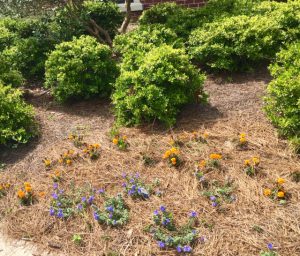Most years, the month of May is a relatively dry, warm month here in Northwest Florida. This Memorial Day weekend forecast shows hot temperatures with little to no rain. It looks like this weather pattern will be similar for at least the short term forecast. The heat, winds and relatively low humidity result in an increase need for wise water use in our lawns and landscapes.
During dry weather, it’s important to implement the following water management practices to improve the water efficiency of your lawn and landscape.

Mulching helps conserve water. On bare ground about sixty percent of the water can be lost through evaporation. A two to three inch layer of mulch will help hold onto the water so the plants can use it. Try to mulch the entire root zone when possible or at least apply mulch all the way around the plants out to the end of the branches.
A thorough soaking to wet the soil to a depth of six to eight inches is better for plants than light frequent watering. Three to five gallons of water applied to one spot under the canopy of trees or shrubs should thoroughly saturate the root zone in that location. During dry periods, twenty-five percent of the root system, when watered thoroughly, can absorb all the water a plant requires at any given time.
When watering lawns, apply one to two inches of water per week when we are not getting rain. Although many sprinklers have irrigation rates of ¼ inch per hour, some may apply up to one inch per hour. Measure your irrigation rate and uniformity by placing several open-top containers of the same size under the sprinkler and see how long it takes to apply a known amount of water such as ½ inch.
An efficient irrigation program on turf should not begin until the lawn grass first shows signs of moisture stress. Signs include a dull, bluish-green color and leaf blades

folding. The most efficient time to irrigate is between sunset and sunrise because of less evaporation, less wind and lower temperatures. Early morning is the next most effective time to irrigate while midday is the least efficient.
Avoid fertilizing drought-stressed plants. Fertilizers are chemical salts and will dehydrate roots when water is in short supply. If you need to apply a pesticide, make certain the plant is not wilted at the time and spray during early morning or late afternoon. Also avoid unnecessary pruning of plants during drought. Pruning encourages new growth which has a high demand for water.
For more information on watering efficiently and drought tolerant plants, contact your County UF/IFAS Extension Office or visit the following website.
http://gardeningsolutions.ifas.ufl.edu/care/irrigation
 0
0
